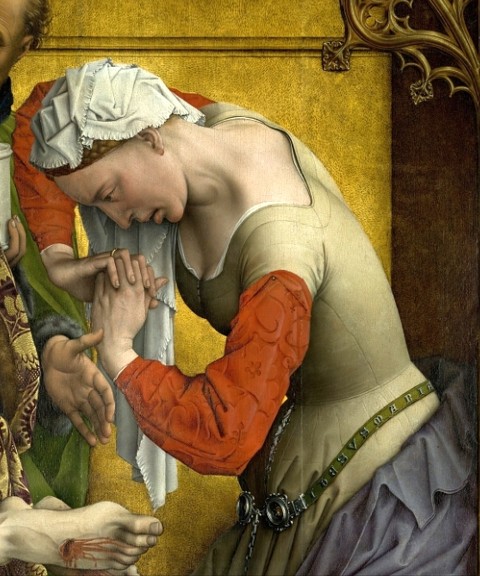Saturday, December 15th, 2012
Mary Magdalene’s Under-Dress
Whenever I want to “wow” my students with the extreme detail of Northern Renaissance painting, I take a few moments to show students some of the amazing details of Rogier van der Weyden’s “Descent from the Cross” altarpiece. Until this evening, though, I failed to notice a small little detail on Mary Magdalene’s sleeve, near her shoulder: the small pin which attaches her separate red over-sleeve to her dress.
To a fifteenth-century viewer, this pin would have been significant. Normally, these pins were concealed by an outer dress. In this instance, though, Mary has omitted to put on her outer dress. In her distress, it appears that Mary Magdalene rushed to the crucifixion without being properly attired! And not only is her under-dress exposed, but her headdress is slipping off of her head.1
In a new book on medieval and Renaissance art, Kim W. Woods argues that this reference to contemporary dress is a carefully constructed detail which would have heightened the sense of reality for a Renaissance viewer.2 That argument makes sense to me.
I also think it is appropriate that the Magdalene, of all people, has rushed out of doors without being properly clothed. There are lots of artistic representations of Mary Magdalene in various states of undress; I’m especially reminded of depictions of the repentant Magdalene in the wilderness. I would be surprised to find any of the other Marys (including the Virgin) depicted in their under-dresses at a crucifixion scene. But, when it comes to art, the Magdalene seems to get away with a lot more.
1 Kim W. Woods, ed., “Art and Visual Culture, 1100-1600: Medieval and Renaissance,” (London: Tate Publishing), 37.
2 Ibid.

M:
Thanks for the great image. The ashen faced Madonna in this piece has always distracted my attention from Mary Magdalen but MM is well worth studying. I don’t think she is wearing two dresses but that it is her cloak that is falling from her shoulders. I don’t think it was by accident that Rogier revealed a little décolletage.
Also, as you point out her veil is in disarray and its end comes as close to touching the foot of Jesus as possible.
Speaking about detail if you blow up her image you will see the letters MARIA on her low-slung belt. Those letters are preceded by (I think) IOESUS.
Frank
Hi Frank! Thanks for your comment. I agree with you: I think that the blue cloth is some kind of cloak. It appears that Mary rushed from her home without even grabbing her outer dress (which would have covered up her sleeve-pins). I’m not an expert in Northern Renaissance fashion, but I think that Giovanni Arnolfini’s wife appears to be wearing an outer dress over her blue sleeves (as shown in her portrait by Jan Van Eyck).
Kim Woods mentions that the van der Weyden’s contorted pose of Mary Magdalene (with her bent arms) was “much imitated” in art (p. 37). I can’t think of other representations of Mary Magdalene in this specific pose off the top of my head, but I’m going to keep my eyes peeled for them!
Wow, indeed.
Just as impressive – if you haven’t seen them already – the latest close-ups of the Ghent altarpiece, which were taken in the recent study. It can be addicting.
http://closertovaneyck.kikirpa.be/
Hi Mary! Thanks for your comment, and for including the Ghent altarpiece link! I saw that website a few months ago, and I got sucked into spending a lot of extra time on that site. I could look at those minor details (and the x-ray versions of the underpainting) for hours!